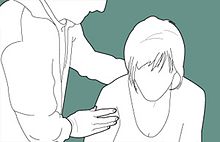Our website is made possible by displaying online advertisements to our visitors.
Please consider supporting us by disabling your ad blocker.
Panic disorder
| Panic disorder | |
|---|---|
 | |
| Depiction of someone with a panic attack, being reassured by another person | |
| Specialty | Psychiatry, clinical psychology |
| Symptoms | Sudden periods of intense fear, palpitations, sweating, shaking, shortness of breath, numbness[1][2] |
| Usual onset | Sudden and recurrent[1] |
| Causes | Unknown[3] |
| Risk factors | Family history, smoking, psychological stress, history of child abuse[2] |
| Diagnostic method | Based on symptoms after ruling out other potential causes[2][3] |
| Differential diagnosis | Heart disease, hyperthyroidism, drug use[2][3] |
| Treatment | Counselling, medications[3] |
| Medication | Antidepressants, benzodiazepines, beta blockers[1][3] |
| Frequency | 2.5% of people at some point[4] |
Panic disorder is a mental and behavioral disorder,[5] specifically an anxiety disorder characterized by reoccurring unexpected panic attacks.[1] Panic attacks are sudden periods of intense fear that may include palpitations, sweating, shaking, shortness of breath, numbness, or a feeling that something terrible is going to happen.[1][2] The maximum degree of symptoms occurs within minutes.[2] There may be ongoing worries about having further attacks and avoidance of places where attacks have occurred in the past.[1]
The exact cause of panic disorder is not fully understood, however there are a number of factors linked to the disorder such as a stressful or traumatic life event, having close family members with the disorder and an imbalance of neurotransmitters.[3] Diagnosis involves ruling out other potential causes of anxiety including other mental disorders, medical conditions such as heart disease or hyperthyroidism, and drug use.[2][3] Screening for the condition may be done using a questionnaire.[6]
Panic disorder is usually treated with counselling and medications.[3] The type of counselling used is typically cognitive behavioral therapy (CBT) which is effective in more than half of people.[3][4] Medications used include antidepressants, benzodiazepines, and beta blockers.[1][3] Following stopping treatment up to 30% of people have a recurrence.[4]
Panic disorder affects about 2.5% of people at some point in their life.[4] It usually begins during adolescence or early adulthood, but may affect people of any age.[3] It is less common in children and elderly people.[2] Women are more likely than men to develop panic disorder.[3]
- ^ a b c d e f g "Anxiety Disorders". Mental Health Information: Health Topics. National Institute of Mental Health. March 2016. Archived from the original on 29 September 2016. Retrieved 1 October 2016.
- ^ a b c d e f g h American Psychiatric Association (2013), Diagnostic and Statistical Manual of Mental Disorders (5th ed.), Arlington: American Psychiatric Publishing, pp. 208–217, 938, ISBN 978-0-89042-555-8
- ^ a b c d e f g h i j k l "Panic Disorder: When Fear Overwhelms". National Institute of Mental Health. 2013. Archived from the original on 4 October 2016. Retrieved 1 October 2016.
- ^ a b c d Craske MG, Stein MB (December 2016). "Anxiety". Lancet. 388 (10063): 3048–3059. doi:10.1016/S0140-6736(16)30381-6. PMID 27349358. S2CID 208789585.
- ^ "F41.0 Panic disorder [episodic paroxysmal anxiety]". The ICD-10 Classification of Mental and Behavioural Disorders Clinical descriptions and diagnostic guidelines. World Health Organization. 2004 [1992]. p. 139. ISBN 92-4-154422-8.
- ^ Herr NR, Williams JW, Benjamin S, McDuffie J (July 2014). "Does this patient have generalized anxiety or panic disorder?: The Rational Clinical Examination systematic review". JAMA. 312 (1): 78–84. doi:10.1001/jama.2014.5950. PMID 25058220.
Previous Page Next Page


